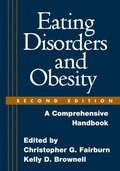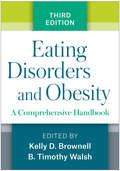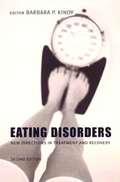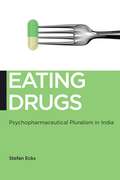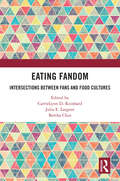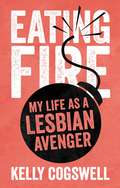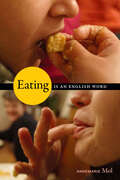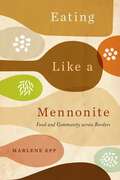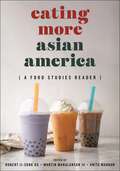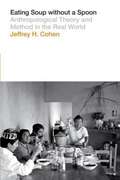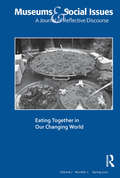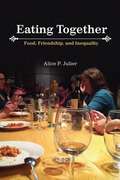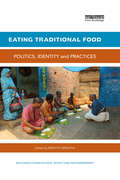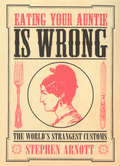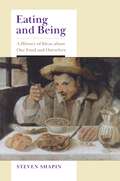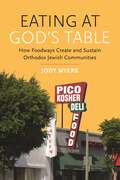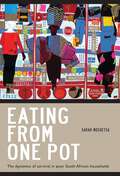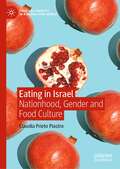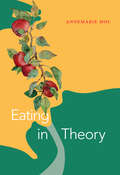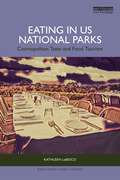- Table View
- List View
Eating Disorders and Child Sexual Abuse
by Lisa HodgeThis book takes up the challenge of examining women’s understandings of eating disorders and child sexual abuse away from a framework focused on pathology. The central argument is that women’s distress is an enactment of their engagement with certain discourses and practices, rather than a reaction triggered by child sexual abuse. Guided by a contemporary feminist framework and Mikhail Bakhtin’s sociological linguistics, to substantiate the argument, women’s own poetry and drawings are used as evidence to develop, support and supplement research findings. The book establishes that an eating disorder is ‘an understandable response’ to sexual trauma and shifts the focus away from ‘a damaged personality’. Even more importantly, it demonstrates that women with eating disorders are using their bodies as a form of resistance to express silenced traumas that remain in the silenced female body. This is an active way of making sense of experiences of child sexual abuse.
Eating Disorders and Obesity, Second Edition
by Christopher G. Fairburn Kelly D. BrownellThis unique handbook presents and integrates virtually all that is currently known about eating disorders and obesity in one authoritative, accessible, and eminently practical volume. From leading international authorities, 112 concise chapters encapsulate the latest information on all pertinent topics, from biological, psychological, and social processes associated with risk, to clinical methods for assessment and intervention. Suggestions for further reading at the end of each chapter replace extended references and enhance the practical value and readability of the volume.
Eating Disorders and Obesity, Third Edition: A Comprehensive Handbook
by Kelly D. Brownell B. Timothy WalshAcclaimed for its encyclopedic coverage, this is the only handbook that synthesizes current knowledge and clinical practices in the fields of both eating disorders and obesity. Like the prior editions, the significantly revised third edition features more than 100 concise, focused chapters with lists of key readings in place of extended references. All aspects of eating disorders and obesity are addressed by foremost clinical researchers: classification, causes, consequences, risk factors, and pathophysiology, as well as prevention, treatment, assessment, and diagnosis. New to This Edition *Reflects 15 years of important advances in both fields, including state-of-the-art intervention approaches and a growing focus on how the brain regulates eating behavior. *Dozens of entirely new chapters. *New topics: epigenetics, body weight and neurocognitive function, stress and emotion regulation, the gut microbiome, surgical devices for obesity, food labeling and marketing, and more. *Expanded coverage of prevention and policy.
Eating Disorders: New Directions in Treatment and Recovery (Issues Ser. #Vol. 127)
by Ed. Kinoy Barbara P.Fully revised to reflect changes in the field, this collection of essays by psychotherapists who specialize in the treatment of anorexia nervosa and bulimia explains in accessible and humane terms how the treatment process works and demonstrates strategies that lead to recovery. The book details the interaction between practitioner and patient, practitioner and practitioner, and family members. The collection, which draws upon the knowledge and experience of clinicians who have practiced at the Wilkins Center for Eating Disorders, also points up the advantages of a collaborative team, for both the patient and professionals.
Eating Disorders: New Directions in Treatment and Recovery, Second Edition
by Barbara P. KinoyFully revised to reflect changes in the field, this collection of essays by psychotherapists details the interaction between practitioner and patient, practitioner and practitioner, and family members.
Eating Drugs: Psychopharmaceutical Pluralism in India (Biopolitics #20)
by Stefan EcksA Hindu monk in Calcutta refuses to take his psychotropic medications. His psychiatrist explains that just as his body needs food, the drugs are nutrition for his starved mind. Does it matter how—or whether—patients understand their prescribed drugs? Millions of people in India are routinely prescribed mood medications. Pharmaceutical companies give doctors strong incentives to write as many prescriptions as possible, with as little awkward questioning from patients as possible. Without a sustained public debate on psychopharmaceuticals in India, patients remain puzzled by the notion that drugs can cure disturbances of the mind. While biomedical psychopharmaceuticals are perceived with great suspicion, many non-biomedical treatments are embraced. Stefan Ecks illuminates how biomedical, Ayurvedic, and homeopathic treatments are used in India, and argues that pharmaceutical pluralism changes popular ideas of what drugs do. Based on several years of research on pharmaceutical markets, Ecks shows how doctors employ a wide range of strategies to make patients take the remedies prescribed. Yet while metaphors such as "mind food" may succeed in getting patients to accept the prescriptions, they also obscure a critical awareness of drug effects.This rare ethnography of pharmaceuticals will be of key interest to those in the anthropology and sociology of medicine, pharmacology, mental health, bioethics, global health, and South Asian studies.
Eating Fandom: Intersections Between Fans and Food Cultures
by CarrieLynn D. Reinhard, Julia E. Largent, and Bertha ChinThis book considers the practices and techniques fans utilize to interact with different aspects and elements of food cultures. With attention to food cultures across nations, societies, cultures, and historical periods, the collected essays consider the rituals and values of fan communities as reflections of their food culture, whether in relation to particular foods or types of food, those who produce them, or representations of them. Presenting various theoretical and methodological approaches, the anthology brings together a series of empirical studies to examine the intersection of two fields of cultural practice and will appeal to sociologists, geographers and scholars of cultural studies with interests in fan studies and food cultures.
Eating Fire: Family Life on the Queer Side
by Michael RiordonEating Fire follows in the steps of Riordon’s popular 1996 book Out our way, on gay and lesbian life in the country (BTL, 1996). This new set of tales examines the range in living patterns and relationships among queer families across Canada. Eating Fire illuminates the rich diversity in which people negotiate their personal and public identities. As in all his writing and radio work, Riordon brings to this book a subtle, direct, and vivid style. For Eating Fire he travelled widely, engaging in significant new research and speaking with hundreds of fascinating people. The resulting book is wanted and needed in classrooms, within queer communities, and among everyone hungry for knowledge about the wide range of Canadian families.
Eating Fire: My Life as a Lesbian Avenger
by Kelly J. CogswellWhen Kelly Cogswell plunged into New York&’s East Village in 1992, she had just come out. An ex–Southern Baptist born in Kentucky, she was camping in an Avenue B loft, scribbling poems, and playing in an underground band, trying to figure out her next move. A couple of months later she was consumed by the Lesbian Avengers, instigating direct action campaigns, battling cops on Fifth Avenue, mobilizing 20,000 dykes for a march on Washington, D.C., and eating fire—literally—in front of the White House.At once streetwise and wistful, Eating Fire is a witty and urgent coming-of-age memoir spanning two decades, from the Culture War of the early 1990s to the War on Terror. Cogswell&’s story is an engaging blend of picaresque adventure, how-to activist handbook, and rigorous inquiry into questions of identity, resistance, and citizenship. It is also a compelling, personal recollection of friendships and fallings-out and of finding true love—several times over. After the Lesbian Avengers imploded, Cogswell describes how she became a pioneering citizen journalist, cofounding the Gully online magazine with the groundbreaking goal of offering &“queer views on everything.&”The first in-depth account of the influential Lesbian Avengers, Eating Fire reveals the group&’s relationship to the queer art and activist scene in early &’90s New York and establishes the media-savvy Avengers as an important precursor to groups such as Occupy Wall Street and La Barbe, in France. A rare insider&’s look at the process and perils of street activism, Kelly Cogswell&’s memoir is an uncompromising and ultimately empowering story of creative resistance against hatred and injustice.
Eating Her Curries and Kway: A Cultural History of Food in Singapore
by Nicole TaruleviczWhile eating is a universal experience, for Singaporeans it carries strong national connotations. The popular Singaporean-English phrase "Die die must try" is not so much hyperbole as it is a reflection of the lengths that Singaporeans will go to find great dishes. <P><P> In Eating Her Curries and Kway: A Cultural History of Food in Singapore, Nicole Tarulevicz argues that in a society that has undergone substantial change in a relatively short amount of time, food serves Singaporeans as a poignant connection to the past. Covering the period from British settlement in 1819 to the present and focusing on the post-1965 postcolonial era, Tarulevicz tells the story of Singapore through the production and consumption of food. <P><P> Analyzing a variety of sources that range from cookbooks to architectural and city plans, Tarulevicz offers a thematic history of this unusual country, which was colonized by the British and operated as a port within Malaya, but which is without a substantial pre-colonial history. <P><P>Connecting food culture to the larger history of Singapore, she discusses various topics including domesticity and home economics, housing and architecture, advertising, and the regulation of food-related manners and public behavior such as hawking, littering, and chewing gum. <P><P>Moving away from the predominantly political and economic focus of other histories of Singapore, Tarulevicz provides an important alternative reading of Singaporean society.
Eating Is an English Word
by Annemarie MolEating is generally understood as a human need that people satisfy in diverse ways. Eating, however, is also an English word. Other languages, using other words, order reality differently: they may fuse eating with breathing, or distinguish chupar from comer. Anthropologists flag such differences by leaving a few of their words untranslated, but what language do we think in? This isn’t necessarily English. We may be linguistically closer to those whose practices we study: them. Against this background, Eating Is an English Word argues that social scientists should let go of the dream of universal concepts. Our analytical terms had better vary. Annemarie Mol and her coauthors exemplify this in a series of material semiotic inquiries into eating practices. They employ terms like lekker, tasting with fingers, chupar, schmecka, gustar, and settling on an okay meal to explore appreciative modes of valuing. Welcome, then, to spirited stories about satisfied stomachs, love for a lamb, juicy fruit treats, and companionable lunches and dinners.
Eating Like a Mennonite: Food and Community across Borders
by Marlene EppMennonites are often associated with food, both by outsiders and by Mennonites themselves. Eating in abundance, eating together, preserving food, and preparing so-called traditional foods are just some of the connections mentioned in cookbooks, food advertising, memoirs, and everyday food talk. Yet since Mennonites are found around the world – from Europe to Canada to Mexico, from Paraguay to India to the Democratic Republic of the Congo – what can it mean to eat like one?In Eating Like a Mennonite Marlene Epp finds that the answer depends on the eater: on their ancestral history, current home, gender, socio-economic position, family traditions, and personal tastes. Originating in central Europe in the sixteenth century, Mennonites migrated around the world even as their religious teachings historically emphasized their separateness from others. The idea of Mennonite food became a way of maintaining community identity, even as unfamiliar environments obliged Mennonites to borrow and learn from their neighbours. Looking at Mennonites past and present, Epp shows that foodstuffs (cuisine) and foodways (practices) depend on historical and cultural context. She explores how diets have evolved as a result of migration, settlement, and mission; how food and gender identities relate to both power and fear; how cookbooks and recipes are full of social meaning; how experiences and memories of food scarcity shape identity; and how food is an expression of religious beliefs – as a symbol, in ritual, and in acts of charity.From zwieback to tamales and from sauerkraut to spring rolls, Eating Like a Mennonite reveals food as a complex ingredient in ethnic, religious, and personal identities, with the ability to create both bonds and boundaries between people.
Eating More Asian America: A Food Studies Reader
by Anita Mannur Robert Ji-Song Ku Martin F. Manalansan, IVThe diversity of Asian American food cultureAsian American-inspired foods are everywhere—or so it seems. A decade ago, chop suey, sushi, curry, adobo, and kimchi were emblematic of Asian American culinary influence. Today, boba, ube, bibingka, phở, matcha, gochujang, and málà have joined the roster of foods strongly associated with Asian Americans. These foods were once considered exotic but now are embraced by mainstream culture.Food studies continues to be an appetizing area of Asian American studies. Eating More Asian America is a follow-up to the influential Eating Asian America, and it provides a rich illustration of the intersection of Asian America and its various foodways. The book posits that food is never simply sustenance—the comestible material that provides fuel for our bodies. Rather, food is a way of knowing, a way of being, and a way of understanding. The essays in Eating More Asian America convey the intellectual richness of various foodways as they intersect with and inform the racial and political construct known as “Asian America.”The twenty-one essays in this volume reflect the diversity of Asian America itself as well as the subfield of food studies. The volume not only offers coverage in terms of topics and types of ethnic food, it also provides a rich and impressive array of methodological approaches. A veritable feast for the senses, Eating More Asian America explores the myriad ways critical eating studies has developed over the past decade.
Eating NAFTA: Trade, Food Policies, and the Destruction of Mexico
by Alyshia GálvezMexican cuisine has emerged as a paradox of globalization. Food enthusiasts throughout the world celebrate the humble taco at the same time that Mexicans are eating fewer tortillas and more processed food. Today Mexico is experiencing an epidemic of diet-related chronic illness. The precipitous rise of obesity and diabetes—attributed to changes in the Mexican diet—has resulted in a public health emergency. In her gripping new book, Alyshia Gálvez exposes how changes in policy following NAFTA have fundamentally altered one of the most basic elements of life in Mexico—sustenance. Mexicans are faced with a food system that favors food security over subsistence agriculture, development over sustainability, market participation over social welfare, and ideologies of self-care over public health. Trade agreements negotiated to improve lives have resulted in unintended consequences for people’s everyday lives.
Eating Soup without a Spoon: Anthropological Theory and Method in the Real World
by Jeffrey H. CohenSignificant scholarship exists on anthropological fieldwork and methodologies. Some anthropologists have also published memoirs of their research experiences. Renowned anthropologist Jeffrey Cohen's Eating Soup without a Spoon is a first-of-its-kind hybrid of the two, expertly melding story with methodology to create a compelling narrative of fieldwork that is deeply grounded in anthropological theory. Cohen's first foray into fieldwork was in 1992, when he lived in Santa Anna del Valle in rural Oaxaca, Mexico. While recounting his experiences studying how rural folks adapted to far-reaching economic changes, Cohen is candid about the mistakes he made and the struggles in the village. From the pressures of gaining the trust of a population to the fear of making errors in data collection, Cohen explores the intellectual processes behind ethnographic research. He offers tips for collecting data, avoiding pitfalls, and embracing the chaos and shocks that come with working in an unfamiliar environment. Cohen's own photographs enrich his vivid portrayals of daily life. In this groundbreaking work, Cohen discusses the adventure, wonder, community, and friendships he encountered during his first year of work, but, first and foremost, he writes in service to the field as a place to do research: to test ideas, develop theories, and model how humans cope and react to the world.
Eating Together in Our Changing World: Museums & Social Issues 7:1 Thematic Issue (Museums & Social Issues)
by Kris Morrissey Emily SparlingFirst Published in 2012. Routledge is an imprint of Taylor & Francis, an Informa company.
Eating Together: Food, Friendship and Inequality
by Alice P. JulierAn insightful map of the landscape of social meals, Eating Together: Food, Friendship, and Inequality argues that the ways in which Americans eat together play a central role in social life in the United States. Delving into a wide range of research, Alice P. Julier analyzes etiquette and entertaining books from the past century and conducts interviews and observations of dozens of hosts and guests at dinner parties, potlucks, and buffets. She finds that when people invite friends, neighbors, or family members to share meals within their households, social inequalities involving race, economics, and gender reveal themselves in interesting ways: relationships are defined, boundaries of intimacy or distance are set, and people find themselves either excluded or included.
Eating Traditional Food: Politics, identity and practices (Routledge Studies in Food, Society and the Environment)
by Brigitte SebastiaDue to its centrality in human activities, food is a meaningful object that necessarily participates in any cultural, social and ideological construction and its qualification as 'traditional' is a politically laden value. This book demonstrates that traditionality as attributed to foods goes beyond the notions of heritage and authenticity under which it is commonly formulated. Through a series of case studies from a global range of cultural and geographical areas, the book explores a variety of contexts to reveal the complexity behind the attribution of the term 'traditional' to food. In particular, the volume demonstrates that the definitions put forward by programmes such as TRUEFOOD and EuroFIR (and subsequently adopted by organisations including FAO), which have analysed the perception of traditional foods by individuals, do not adequately reflect this complexity. The concept of tradition being deeply ingrained culturally, socially, politically and ideologically, traditional foods resist any single definition. Chapters analyse the processes of valorisation, instrumentalisation and reinvention at stake in the construction and representation of a food as traditional. Overall the book offers fresh perspectives on topics including definition and regulation, nationalism and identity, and health and nutrition, and will be of interest to students and researchers of many disciplines including anthropology, sociology, politics and cultural studies.
Eating Your Auntie Is Wrong: The World's Strangest Customs
by Stephen ArnottCrossing continents and centuries Stephen Arnott brings us invaluable information about all kinds of bizarre regional customs - from sexual practices to the received wisdom on cannibalism - that could save you from embarrassing local faux pas while travelling. Did you know that amongst the Tartars, relations of the bride and bridegroom would traditionally divide into two groups and fight each other until some had suffered bleeding wounds? It was thought that causing blood to flow in this way would ensure the couple had strong sons; or that in Hungary, a cure for infertility was to beat a barren woman with a stick? The stick having previously been used to separate mating dogs; or that amongst some Aboriginal tribes of New South Wales that men who had any contact with their mothers-in-law would suffer terrible hard luck? The threat was so great that married men even avoided looking in their mother-in-law's general direction.
Eating and Being: A History of Ideas about Our Food and Ourselves
by Steven ShapinWhat we eat, who we are, and the relationship between the two. Eating and Being is a history of Western thinking about food, eating, knowledge, and ourselves. In modern thought, eating is about what is good for you, not about what is good. Eating is about health, not about virtue. Yet this has not always been the case. For a great span of the past—from antiquity through about the middle of the eighteenth century—one of the most pervasive branches of medicine was known as dietetics, prescribing not only what people should eat but also how they should order many aspects of their lives, including sleep, exercise, and emotional management. Dietetics did not distinguish between the medical and the moral, nor did it acknowledge the difference between what was good for you and what was good. Dietetics counseled moderation in all things, where moderation was counted as a virtue as well as the way to health. But during the nineteenth century, nutrition science began to replace the language of traditional dietetics with the vocabulary of proteins, fats, carbohydrates, and calories, and the medical and the moral went their separate ways. Steven Shapin shows how much depended upon that shift, and he also explores the extent to which the sensibilities of dietetics have been lost. Throughout this rich history, he evokes what it felt like to eat during another historical period and invites us to reflect on what it means to feel about food as we now do. Shapin shows how the change from dietetics to nutrition science fundamentally altered how we think about our food and its powers, our bodies, and our minds.
Eating at God's Table: How Foodways Create and Sustain Orthodox Jewish Communities (Raphael Patai Series in Jewish Folklore and Anthropology)
by Jody MyersHow do contemporary American Orthodox Jews use food to create boundaries, distinguishing and dividing groups from each other and from non-Orthodox communities? How does food symbolize beliefs, sustain and grow communities, and represent commitment to God? Eating at God’s Table explores answers and examples from ten years of ethnographic research in the Orthodox enclave in the west Los Angeles Pico-Robertson neighborhood. Author Jody Myers explores the food-centeredness of Orthodox Jewish religious practice and the evolutionary development of today’s demanding kosher laws. Opening with four scenarios based on real observations, Myers illustrates how many Orthodox residents’ religious beliefs and practices around food are integrated into, even inseparable from, their daily activities. While the shared commitment to the kosher diet creates an overall sense of community, Orthodox sub-affiliations in the neighborhood use foodways to construct smaller, intimate communities, and individuals use food to fashion personal identities within the larger group. This rich exploration of kosher Orthodox foodways and their meanings demonstrates the inadequacy of limited or simple definitions of Orthodox Jewishness and offers insight into the religious diversity in American communities.
Eating from One Pot: The dynamics of survival in poor South African households
by Sarah MosoetsaAs poverty and unemployment deepen in contemporary South Africa, the burning question becomes, how do the poor survive? Eating from One Pot provides a compelling answer. Based on intensive fieldwork, it shows how many African households are on the brink of collapse. That they keep going at all can largely be attributed to the struggles of older women against poverty. They are the fulcrum on which household survival turns. This book describes how households in two different areas in KwaZulu-Natal are sites of both stability and conflict. As one of the interviewees put it: ‘We eat from one pot and should always help each other.’ Yet the stability of family networks is becoming fragile because of the enormous burden placed on them by unemployment and unequal power relations. Through careful analysis, the experiences of survival are discussed in relation to the restructuring of the country's welfare and social policies, and the extension of social grants. Mosoetsa argues that these policies shape the livelihoods that people pursue in order to survive under desperate conditions, but fail to address the root causes of poverty and inequality.
Eating in Israel: Nationhood, Gender and Food Culture (Food and Identity in a Globalising World)
by Claudia Prieto PiastroThis book explores the relationship between the food culture of Israel and the creation of its national identity. It is an effort to research what the mundane, everyday behaviours such as cooking and feeding ourselves and others, can tell us about the places we were born and the cultural practices of a nation. With the aim of developing a better understanding of the many facets of Israeli nationalism, this ethnographic work interrogates how ordinary Israelis, in particular women, use food in their everyday life to construct, perform and resist national narratives. It explores how Israeli national identity is experienced through its food culture, and how social and political transformations are reflected in the consumption patterns of Israeli society. The book highlights understudied themes in anthropology, food studies and gender studies, and focuses on three key themes: food and national identity construction, the role of women as feeders of the nation, and everyday nationhood. It is a relevant work for researchers and students interested in the study of food, gender, nationalism and the Middle East; as well as for food writers and bloggers alike.
Eating in Theory (Experimental Futures)
by Annemarie MolAs we taste, chew, swallow, digest, and excrete, our foods transform us, while our eating, in its turn, affects the wider earthly environment. In Eating in Theory Annemarie Mol takes inspiration from these transformative entanglements to rethink what it is to be human. Drawing on fieldwork at food conferences, research labs, health care facilities, restaurants, and her own kitchen table, Mol reassesses the work of authors such as Hannah Arendt, Maurice Merleau-Ponty, Hans Jonas, and Emmanuel Levinas. They celebrated the allegedly unique capability of humans to rise above their immediate bodily needs. Mol, by contrast, appreciates that as humans we share our fleshy substance with other living beings, whom we cultivate, cut into pieces, transport, prepare, and incorporate—and to whom we leave our excesses. This has far-reaching philosophical consequences. Taking human eating seriously suggests a reappraisal of being as transformative, knowing as entangling, doing as dispersed, and relating as a matter of inescapable dependence.
Eating in US National Parks: Cosmopolitan Taste and Food Tourism (Routledge Food Studies)
by Kathleen LeBescoThis book presents a fascinating exploration of eating experiences within US national parks, explaining how, on what, and why people eat in national parks and how this has changed over the last century. National parks are enjoying unprecedented popularity, and they are especially popular sites for the expression of cosmopolitanism, an ideological outlook descended from the Romantics on whose vision the parks were originally founded. The book explores the constructed foodscape within US national parks, situating the romantic consumption ethos within the context of sociological work on distinction, culinary tourism, and culinary capital. It analyzes and problematizes elements of cosmopolitan taste and desire, examining food tourism in wilderness spaces that satisfies cosmopolitan hunger for authenticity and a certain type of self-making. Weaving together strands of research that have not been previously integrated, the book gleans meaning from concessions menus and park restaurant web pages and employs audience analysis to take stock of park restaurant visitors’ contributions to restaurant review websites, as well as to understand how they represent their park eating experiences on social media. The book examines how satisfying cosmopolitan tastes in the parks creates profit for corporate concessioners, but also may produce bioregionalist successes and a recentering of Indigenous foodways. It concludes by exploring inroads to a better food experience in the parks, involving food products and processes that are regionally/locally specific, where tourists witness and participate in food production and enjoy commensality, but that are also non-extractive and show care for the environment and the people who inhabit it. This book will be of great interest to students and scholars of food studies, tourism and hospitality, sociology of culture, parks and recreation, American studies, and environmental studies. The book will also be of interest to parks and recreation decision makers, sustainable tourism leaders, and hospitality managers.

